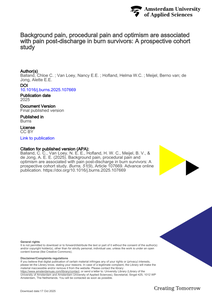Background and aim: Moderate preterm (MP) birth is associated with an increased risk of developmental problems. However, post-discharge support for this group is scarce. The aim of this study was to evaluate the feasibility of a post-discharge parenting program (TOP program) for MP infants. Three feasibility dimensions were evaluated (1) recruitment capability and compliance, (2) intervention acceptability, and (3) limited efficacy testing. Methods: A group of MP infants with a gestational age (GA) between 320/7‐346/7 weeks and their parents received six home visits by a TOP interventionist until 6 months corrected age (CA). A pre-posttest intervention design with quantitative and qualitative measures was used. Recruitment capability and compliance, acceptability, and satisfaction with the intervention were evaluated using a questionnaire, checklists, interviews, and a focus group. Infant socio-emotional development, parental distress, self-efficacy, and reflective functioning were measured with questionnaires. Observation measurements were used for infant motor development and parental sensitivity. Results: Thirty-two families completed the six home visits. The satisfaction rate (scale 0–10) was remarkably high (Mean 9.4, range: 8–10). Parents reported that the program was suitable, enhanced their understanding of their infants' developmental needs, and increased their self-efficacy. The infants showed age-appropriate motor and socio-emotional development post-intervention. Parental self-efficacy, reflective functioning, and sensitivity improved from pre to post intervention, with small to large effect sizes. Conclusion: The study demonstrated high compliance, acceptability, and satisfaction with the TOP program for MP infants with promising infant and parent outcomes. This study contributes to the preparatory work prior to a larger scale evaluation and dissemination.
DOCUMENT

Pain following burn injuries can be severe and may persist after hospital discharge. The experience of pain is influenced by multiple biological and psychosocial factors. Post-discharge pain may be related to pain experienced during hospitalization as well as anxiety associated with these pain experiences. There are also protective factors; one notable example is optimism. However, the role of optimism in burn-related pain has not yet been investigated. This study aimed to describe the extent of pain measured over 14 consecutive days post-discharge and to examine its relationship with background pain, procedural pain, pain-related anxiety, and optimism. This multi-center longitudinal cohort study was conducted in five burns centres. The results showed that 50 % of the patients had a pain score ≥ 2 on a 0 – 10 scale after discharge, which on average decreased further over the next 14 days. However, a subgroup of patients maintained elevated pain levels. Patients with higher pain scores post-discharge were more likely to have experienced higher levels of background pain and procedural pain in-hospital and they scored lower on optimism. Pain-related anxiety did not independently contribute to pain post-discharge. The results indicate that patients with high pain scores during hospital admission may need specific attention regarding pain management when they leave the hospital. Furthermore, patients may benefit from optimism-inducing interventions in the hospital and thereafter.
DOCUMENT

BACKGROUND: Medication-related problems are common after hospitalization, for example when changes in patients' medication regimens are accompanied by insufficient patient education, poor information transfer between healthcare providers, and inadequate follow-up post-discharge. We investigated the effect of a pharmacy-led transitional care program on the occurrence of medication-related problems four weeks post-discharge.METHODS: A prospective multi-center before-after study was conducted in six departments in total of two hospitals and 50 community pharmacies in the Netherlands. We tested a pharmacy-led program incorporating (i) usual care (medication reconciliation at hospital admission and discharge) combined with, (ii) teach-back at hospital discharge, (iii) improved transfer of medication information to primary healthcare providers and (iv) post-discharge home visit by the patient's own community pharmacist, compared with usual care alone. The difference in medication-related problems four weeks post-discharge, measured by means of a validated telephone-interview protocol, was the primary outcome. Multiple logistic regression analysis was used, adjusting for potential confounders after multiple imputation to deal with missing data.RESULTS: We included 234 (January-April 2016) and 222 (July-November 2016) patients in the usual care and intervention group, respectively. Complete data on the primary outcome was available for 400 patients. The proportion of patients with any medication-related problem was 65.9% (211/400) in the usual care group compared to 52.4% (189/400) in the intervention group (p = 0.01). After multiple imputation, the proportion of patients with any medication-related problem remained lower in the intervention group (unadjusted odds ratio 0.57; 95% CI 0.38-0.86, adjusted odds ratio 0.50; 95% CI 0.31-0.79).CONCLUSIONS: A pharmacy-led transitional care program reduced medication-related problems after discharge. Implementation research is needed to determine how best to embed these interventions in existing processes.
DOCUMENT
